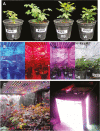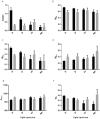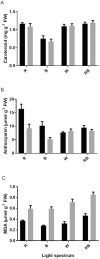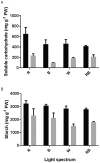Effects of growth under different light spectra on the subsequent high light tolerance in rose plants
- PMID: 30349659
- PMCID: PMC6191502
- DOI: 10.1093/aobpla/ply052
Effects of growth under different light spectra on the subsequent high light tolerance in rose plants
Abstract
Photosynthesis is defined as a light-dependent process; however, it is negatively influenced by high light (HL) intensities. To investigate whether the memory of growth under monochromatic or combinational lights can influence plant responses to HL, rose plants were grown under different light spectra [including red (R), blue (B), 70:30 % red:blue (RB) and white (W)] and were exposed to HL (1500 μmol m-2 s-1) for 12 h. Polyphasic chlorophyll a fluorescence (OJIP) transients revealed that although monochromatic R- and B-grown plants performed well under control conditions, the functionality of their electron transport system was more sensitive to HL than that of the RB- and W-grown plants. Before exposure to HL, the highest anthocyanin concentration was observed in R- and B-grown plants, while exposure to HL reduced anthocyanin concentration in both R- and B-grown plants. Ascorbate peroxidase and catalase activities decreased, while superoxide dismutase activity was increased after exposure to HL. This caused an increase in H2O2 concentration and malondialdehyde content following HL exposure. Soluble carbohydrates were decreased by exposure to HL, and this decrease was more emphasized in R- and B-grown plants. In conclusion, growing plants under monochromatic light reduced the plants ability to cope with HL stress.
Keywords: Antioxidant enzymes; high light; light spectrum; photosynthesis; pigments.
Figures













References
-
- Ahmad P, Jaleel CA, Salem MA, Nabi G, Sharma S. 2010. Roles of enzymatic and nonenzymatic antioxidants in plants during abiotic stress. Critical Reviews in Biotechnology 30: 161–175. - PubMed
-
- Aliniaeifard S, Malcolm Matamoros P, van Meeteren U. 2014. Stomatal malfunctioning under low VPD conditions: induced by alterations in stomatal morphology and leaf anatomy or in the ABA signaling?Physiologia Plantarum 152:688–699. - PubMed
-
- Aro EM, Virgin I, Andersson B. 1993. Photoinhibition of photosystem II. Inactivation, protein damage and turnover. Biochimica et Biophysica Acta (BBA)-Bioenergetics 1143:113–134. - PubMed
LinkOut - more resources
Full Text Sources

